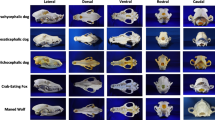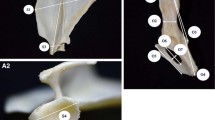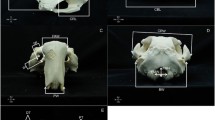Abstract
In many mammals, gender and skull shape are related to the bone morphology of the entire body; however, this has not been well established in the domestic cat (Felis catus). This study aims to find a relationship between cervical, thoracic and lumbar vertebrae morphometrics with regard to the sex and skull shape of domestic cats. A total of 79 samples obtained from 92 dried bones of domestic cats were used to determine morphometric measurements for a total of 29 parameters. Hierarchical clustering was used to cluster the vertebral bones found in three groups: C3-T1, T2-T11 and T12-L7. The skull shape identification process employed discriminative analysis and revealed the highest training data accuracy rate at up to 86.20% in T4 followed by L1 (86.04%) Axis (85.71%) and C5 (85.18%). Sex identification employed discriminative analysis and displayed the highest training data accuracy rate at up to 75.58% in L1 followed by, T7 (71.87%) and C6 (71.79%). Moreover, we found that 14% of the samples had one vertebra missing (T13 or L1). In conclusion, domestic cat vertebral morphometrics were found to be more related to skull shape than gender. In addition, bone clustering employed morphometric data and yielded a result that was similar to that of traditional cluster analysis involving body regions.



Similar content being viewed by others
References
Albanese J, Cardoso HFV, Saunders SR (2005) Universal methodology for developing univariate sample-specific sex determination methods: an example using the epicondylar breadth of the humerus. J Archaeol 32:143–152
Alpak H, Mutus R, Onar V (2004) Correlation analysis of the skull and long bone measurements of the dog. Ann Anat 186:323–330
Bali MS, Lang J, Jaggy A, Spreng D, Doherr MG, Forterre F (2009) Comparative study of vertebral fractures and luxations in dogs and cats. Vet Comp Orthop Traumatol 22:47–53
Bastir M, Higuero A, Rios L, Garcia Martinez D (2014) Three-dimensional analysis of sexual dimorphism in human thoracic vertebrae: implications for the respiratory system and spine morphology. Am J Phys Anthropol 155:513–521
Baumgart M, Wiśniewski M, Grzonkowska M, Małkowski B, Badura M, Szpinda M (2016) Morphometric study of the neural ossification centers of the atlas and axis in the human fetus. Surg Radiol Anat 38:1205–1215
Bogduk N (2016) Functional anatomy of the spine. Handb Clin Neurol 136:675–688
Boonsri B, Pitakarnnop T, Buddhachat K, Changtor P, Nganvongpanit K (2019) Can feline (Felis catus) flat and long bone morphometry predict sex or skull shape? Anat Sci Int 94:245–256
Chmielowiec K, Tatara M, Krupski W, Luszczewska S, Bienko M, Szabelska A, Jakubczak A, Kostro K (2014) Sex-related differences of morphometric and densitometric properties of lumbar vertebrae in silver foxes (Vulpes vulpes). Bone Abstract 3:44
Dibennardo R, Taylor JV (1983) Multiple discriminant function analysis of sex and race in the postcranial skeleton. Am J Phys Anthropol 61:305–314
Gama I, Navega D, Cunha E (2015) Sex estimation using the second cervical vertebra: a morphometric analysis in a documented Portuguese skeletal sample. Int J Legal Med 129:365–372
Hecht S, Huerta MM, Reed RB (2014) Magnetic resonance imaging (MRI) spinal cord and canal measurements in normal dogs. Anat Histol Embryol 43:36–41
Ianuzzi A, Pickar JG, Khalsa PS (2009) Determination of torque-limits for human and cat lumbar spine specimens during displacement-controlled physiological motions. Spine J 9:77–86
Jeffery ND (2010) Vertebral fracture and luxation in small animals. Vet Clin North Am Small Anim Pract 40:809–828
Kaeswaren Y, Hackman L (2019) Sexual dimorphism in the cervical vertebrae and its potential for sex estimation of human skeletal remains in a white scottish population. Forensic Sci Int 1:100023
Krishan K, Chatterjee PM, Kanchan T, Kaur S, Baryah N, Singh RK (2016) A review of sex estimation techniques during examination of skeletal remains in forensic anthropology casework. Forensic Sci Int 261:165.e161–165.e168
Macpherson JM, Ye Y (1998) The cat vertebral column: stance configuration and range of motion. Exp Brain Res 119:324–332
Marino EA (1995) Sex estimation using the first cervical vertebra. Am J Phys Anthropol 97:127–133
Meseke CA, Duray SM, Brillon SR (2008) Principal components analysis of the atlas vertebra. J Manipulative Physiol Ther 31:212–216
Monteiro CL, Campos AI, Madeira VL, Silva HV, Freire LM, Pinto JN, de Souza LP, da Silva LD (2013) Pelvic differences between brachycephalic and mesaticephalic cats and indirect pelvimetry assessment. Vet Rec 172:16
Narita Y, Kuratani S (2005) Evolution of the vertebral formulae in mammals: a perspective on developmental constraints. J Exp Zool B Mol Dev Evol 304:91–106
Nganvongpanit K, Pitakarnnop T, Buddhachat K, Phatsara M (2017) Gender-related differences in pelvic morphometrics of the Retriever dog breed. Anat Histol Embryol 46:51–57
Pitakarnnop T, Buddhachat K, Euppayo T, Kriangwanich W, Nganvongpanit K (2017) Feline (Felis catus) skull and pelvic morphology and morphometry: gender-related difference? Anat Histol Embryol 46:294–303
Premchandran D, Saralaya VV, Mahale A (2014) Predicting lumbar central canal stenosis—a magnetic resonance imaging study. J Clin Diagn Res 8:RC01–RC04
Randau M, Goswami A (2017) Morphological modularity in the vertebral column of Felidae (Mammalia, Carnivora). BMC Evol Biol 17:133
Randau M, Goswami A, Hutchinson JR, Cuff AR, Pierce SE (2016) Cryptic complexity in felid vertebral evolution: shape differentiation and allometry of the axial skeleton. Zool J Linn Soc 178:183–202
Wescott DJ (2000) Sex variation in the second cervical vertebra. J Forensic Sci 45:462–466
Wessels NK, Center EM (1992) Vertebrates. Jones & Bartlett Learning LLC, Burlington
Acknowledgements
The authors would like to thank the Excellence Center in Veterinary Bioscience, Chiang Mai University for providing the research grant. We would like to acknowledge the provision of specimens by the Veterinary Anatomy and Pathology Museum, Faculty of Veterinary Medicine, Chiang Mai University, Thailand.
Author information
Authors and Affiliations
Contributions
B.B. and K.N. conceived of and designed the experiments; B.B. performed the experiments, analyzed the results and prepared figures and tables. K.B. and V.P. offered advice on statistical analysis. M.P. provided advice on bone measurements. All authors have read and approved of the final version of this manuscript.
Corresponding author
Ethics declarations
Conflict of interest
All authors declare that they no conflict interest.
Additional information
Publisher's Note
Springer Nature remains neutral with regard to jurisdictional claims in published maps and institutional affiliations.
Rights and permissions
About this article
Cite this article
Boonsri, B., Buddhachat, K., Punyapornwithaya, V. et al. Determination of whether morphometric analysis of vertebrae in the domestic cat (Felis catus) is related to sex or skull shape. Anat Sci Int 95, 387–398 (2020). https://doi.org/10.1007/s12565-020-00533-3
Received:
Accepted:
Published:
Issue Date:
DOI: https://doi.org/10.1007/s12565-020-00533-3




